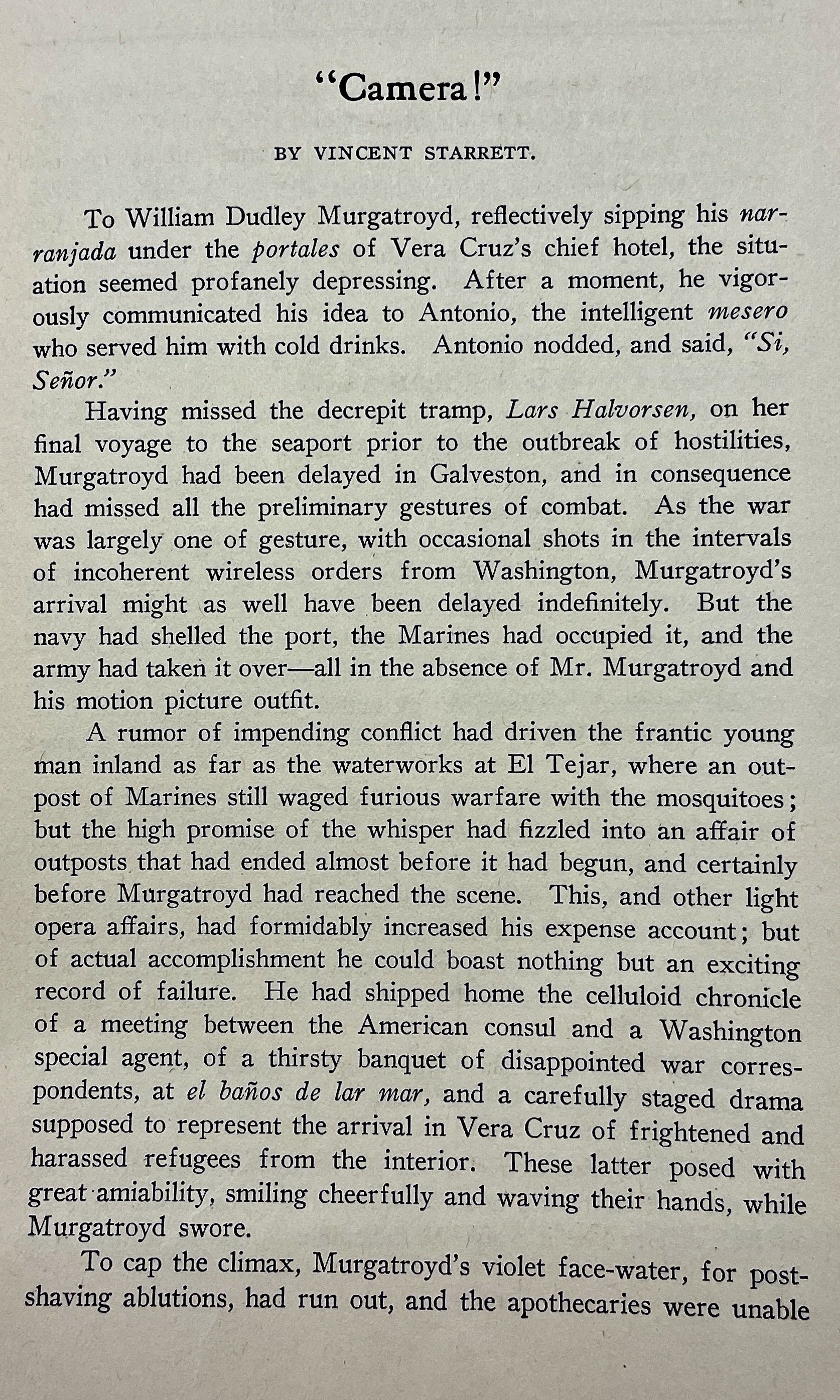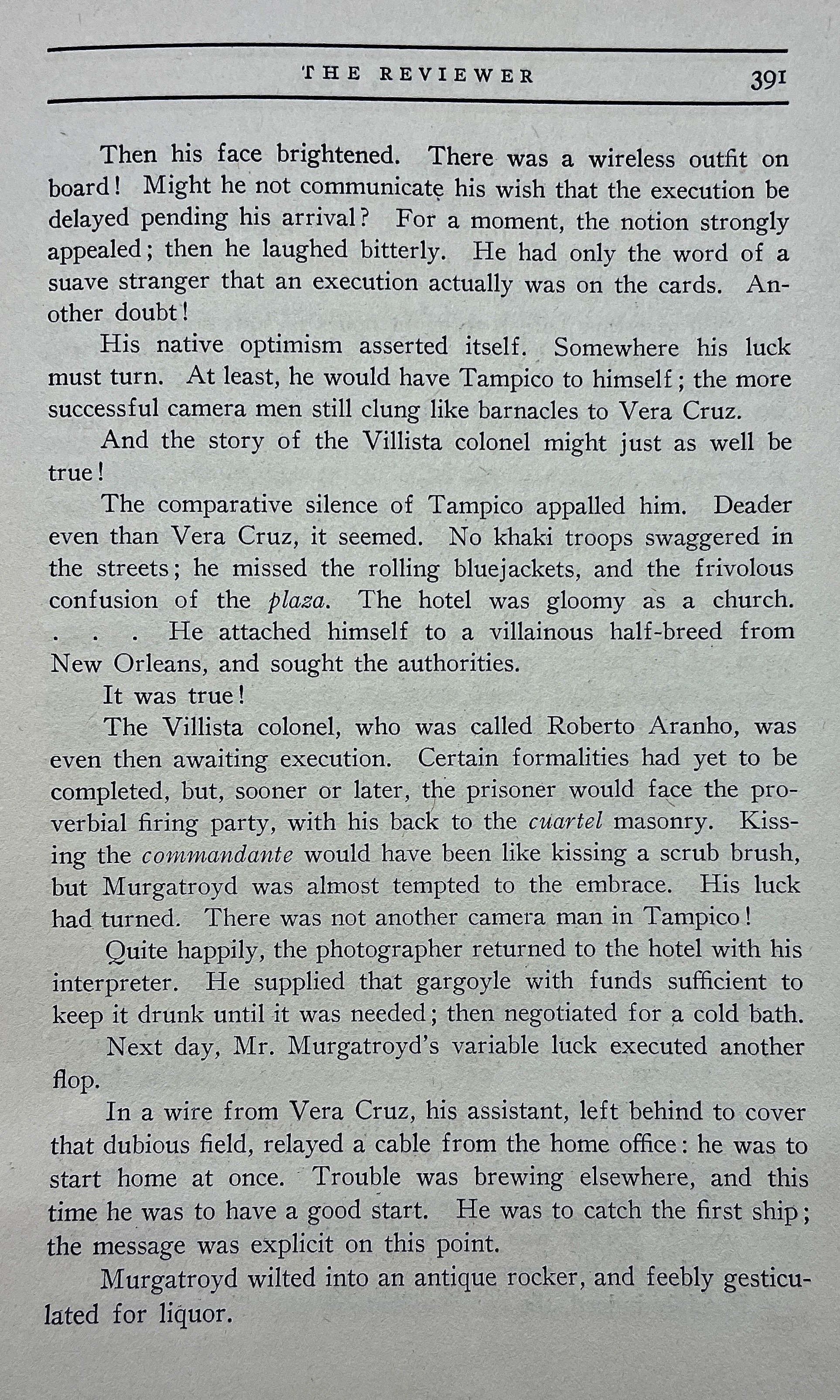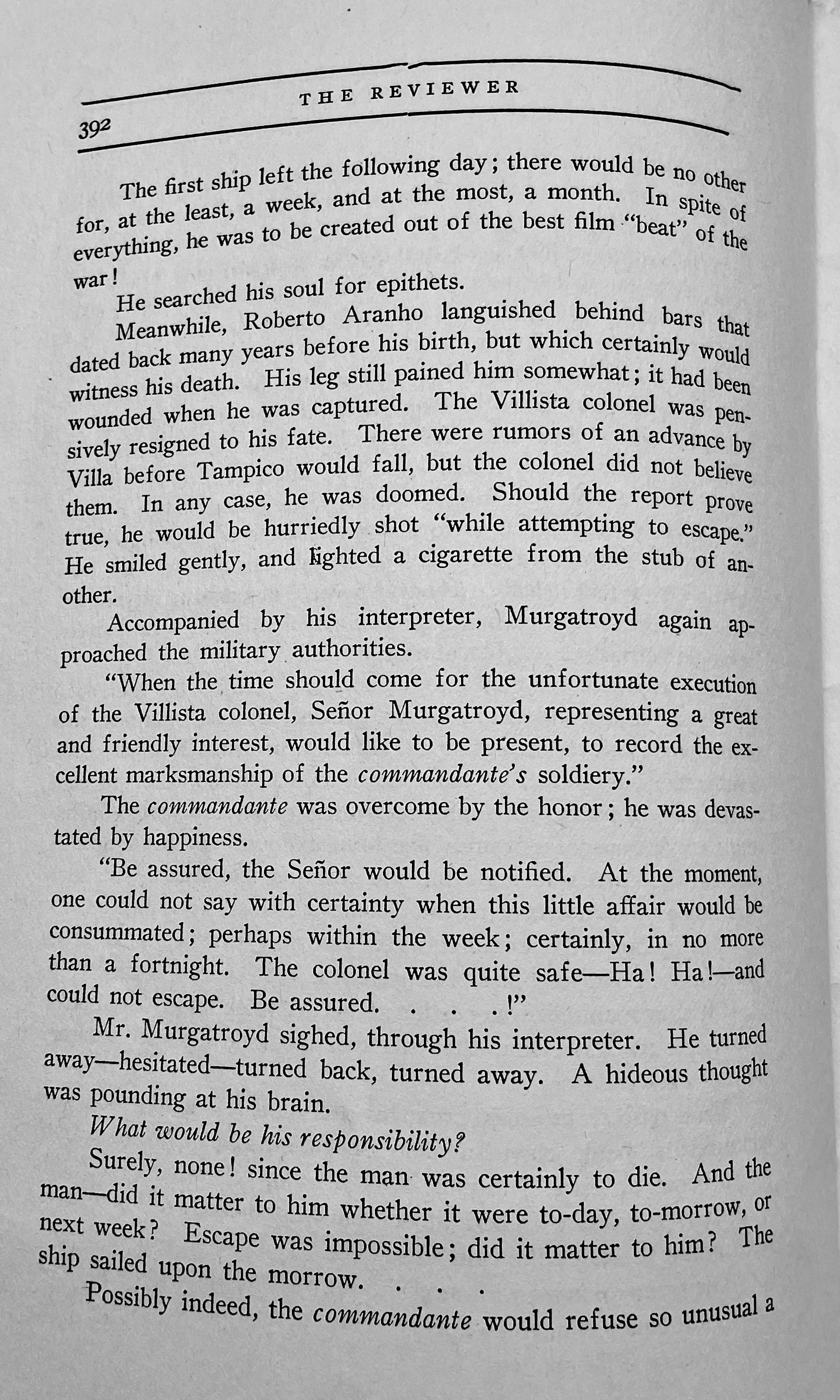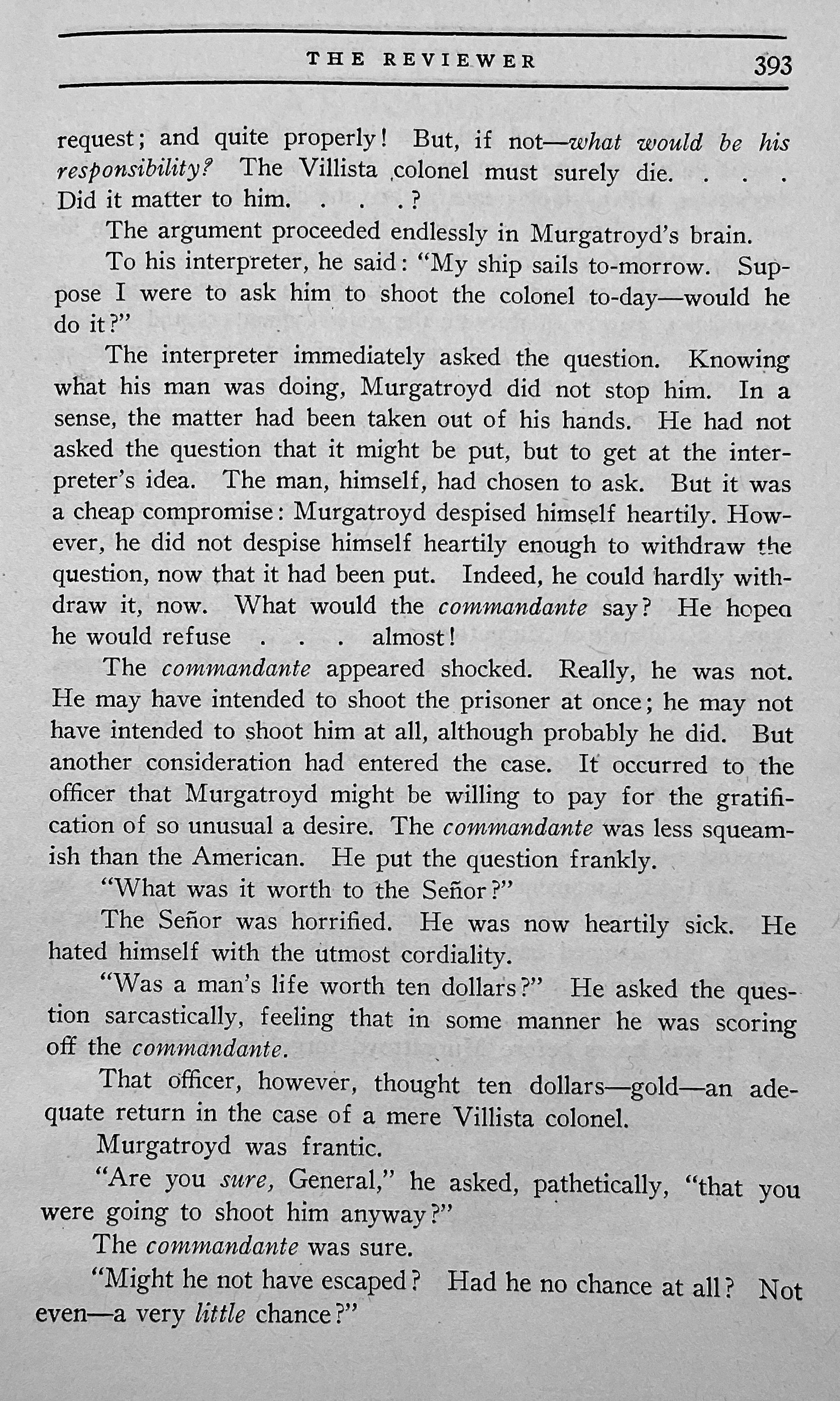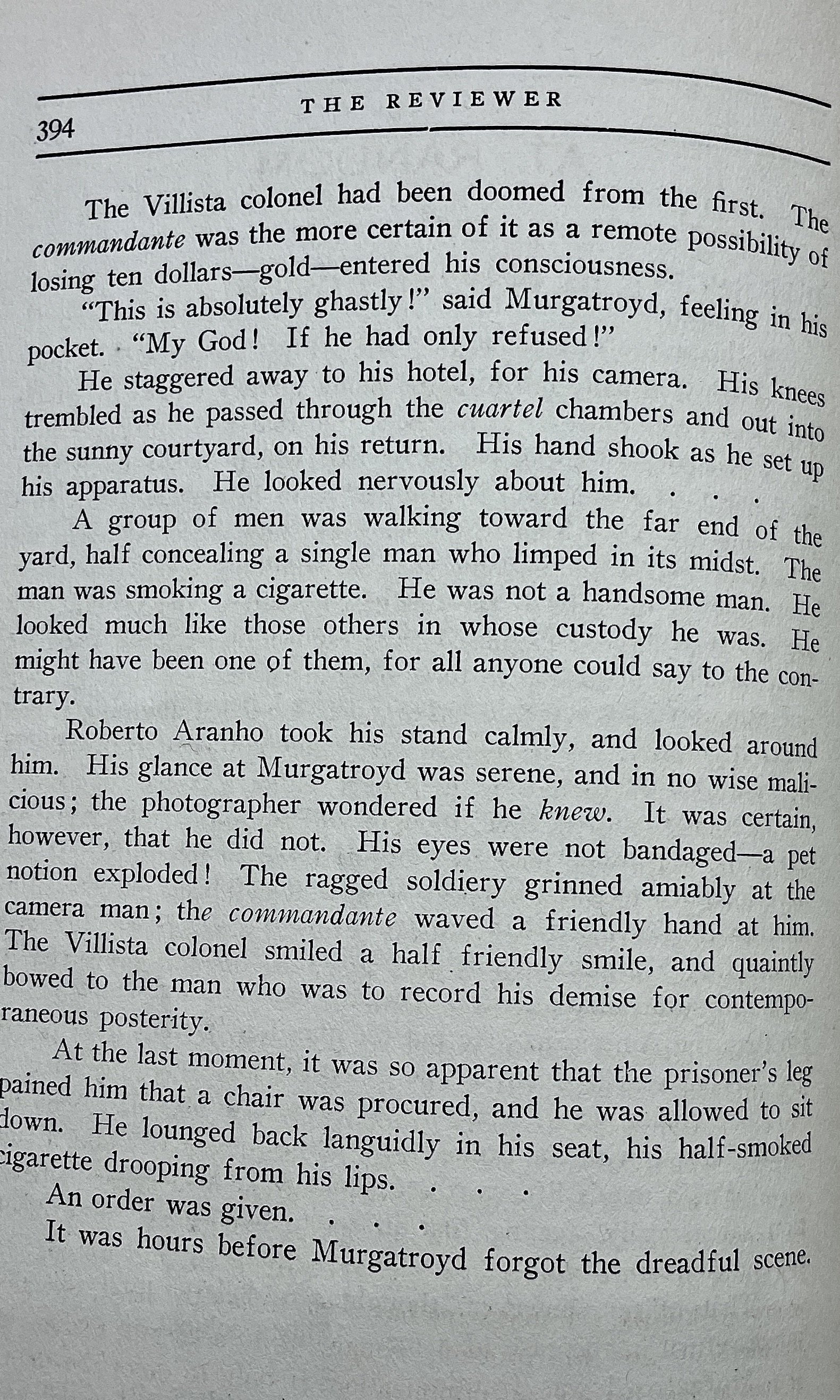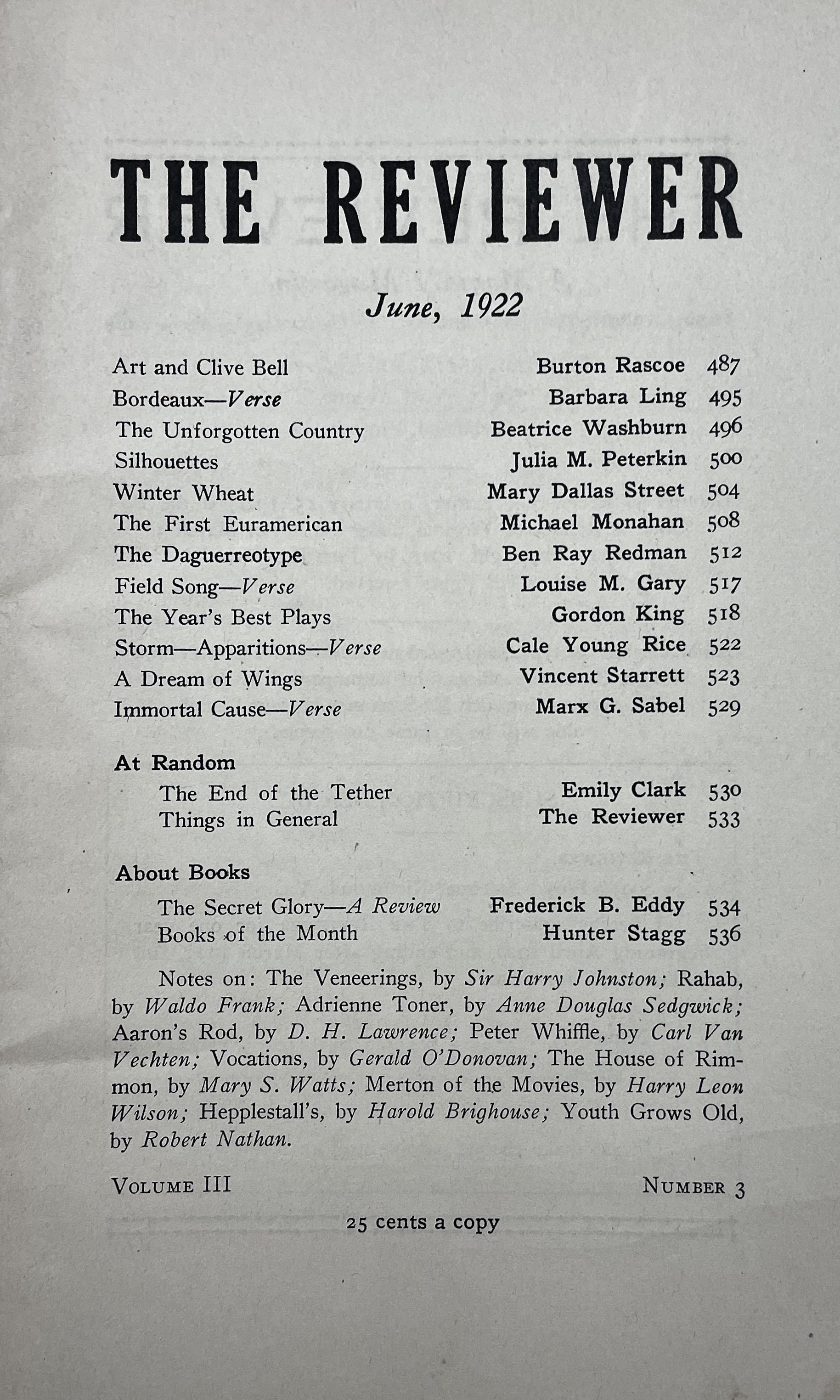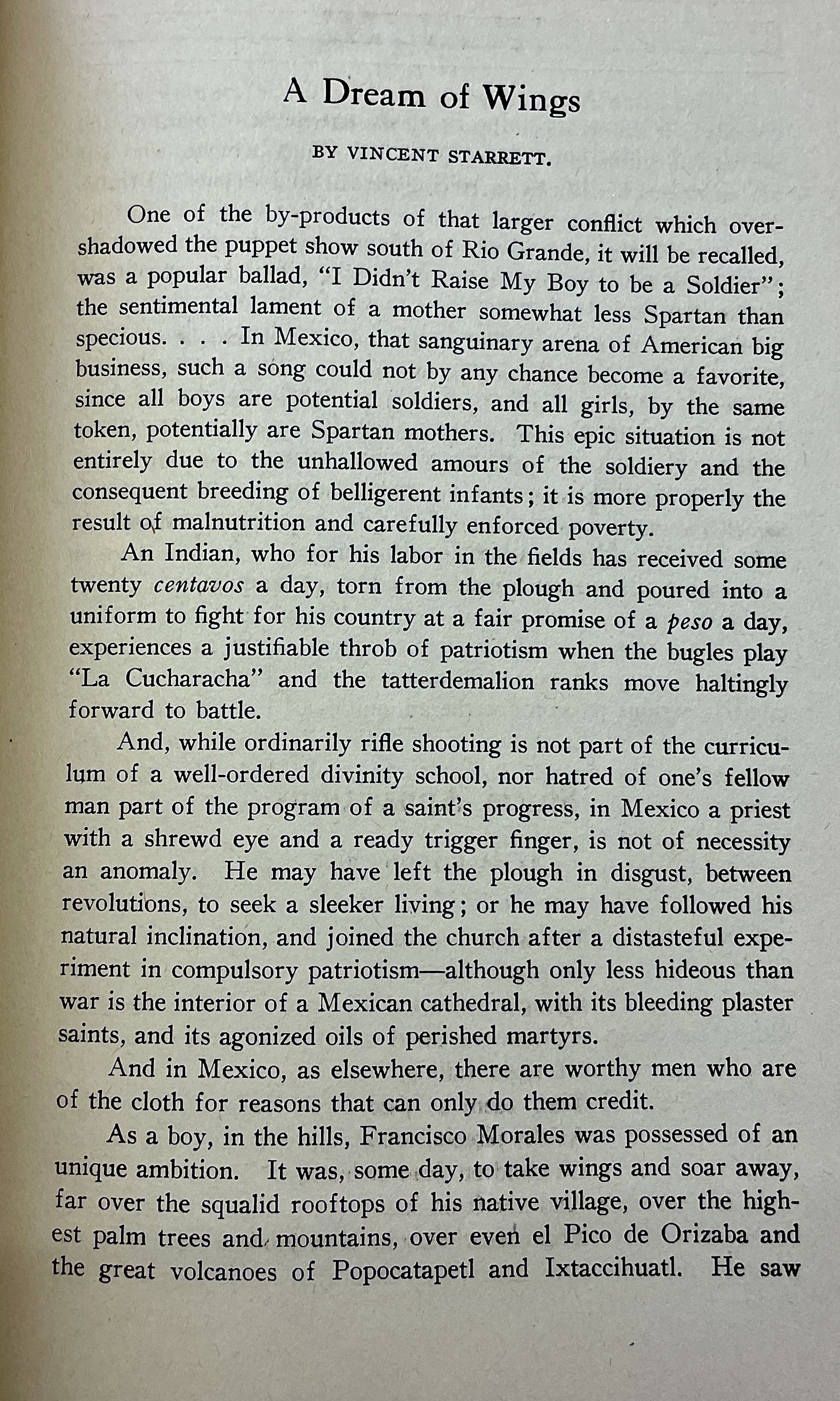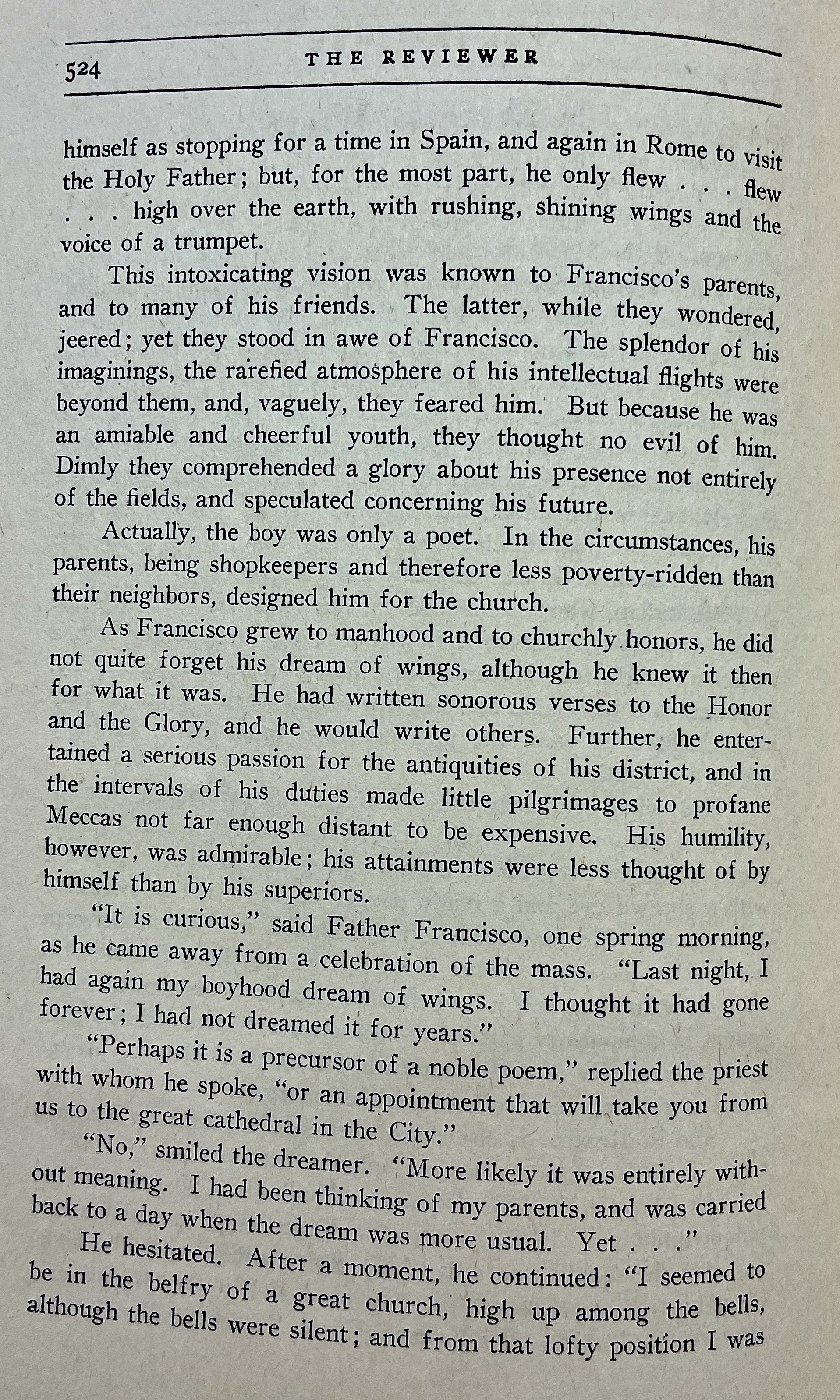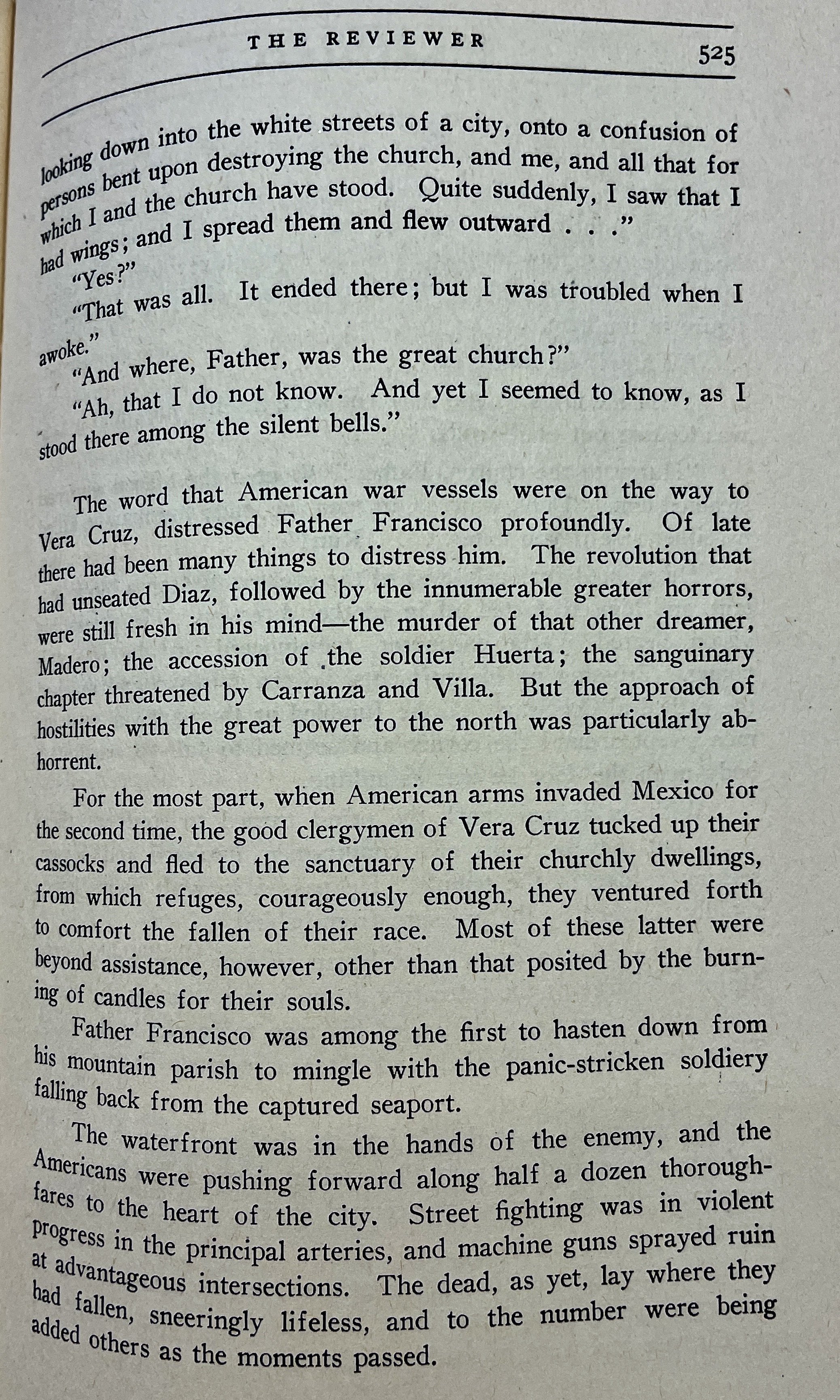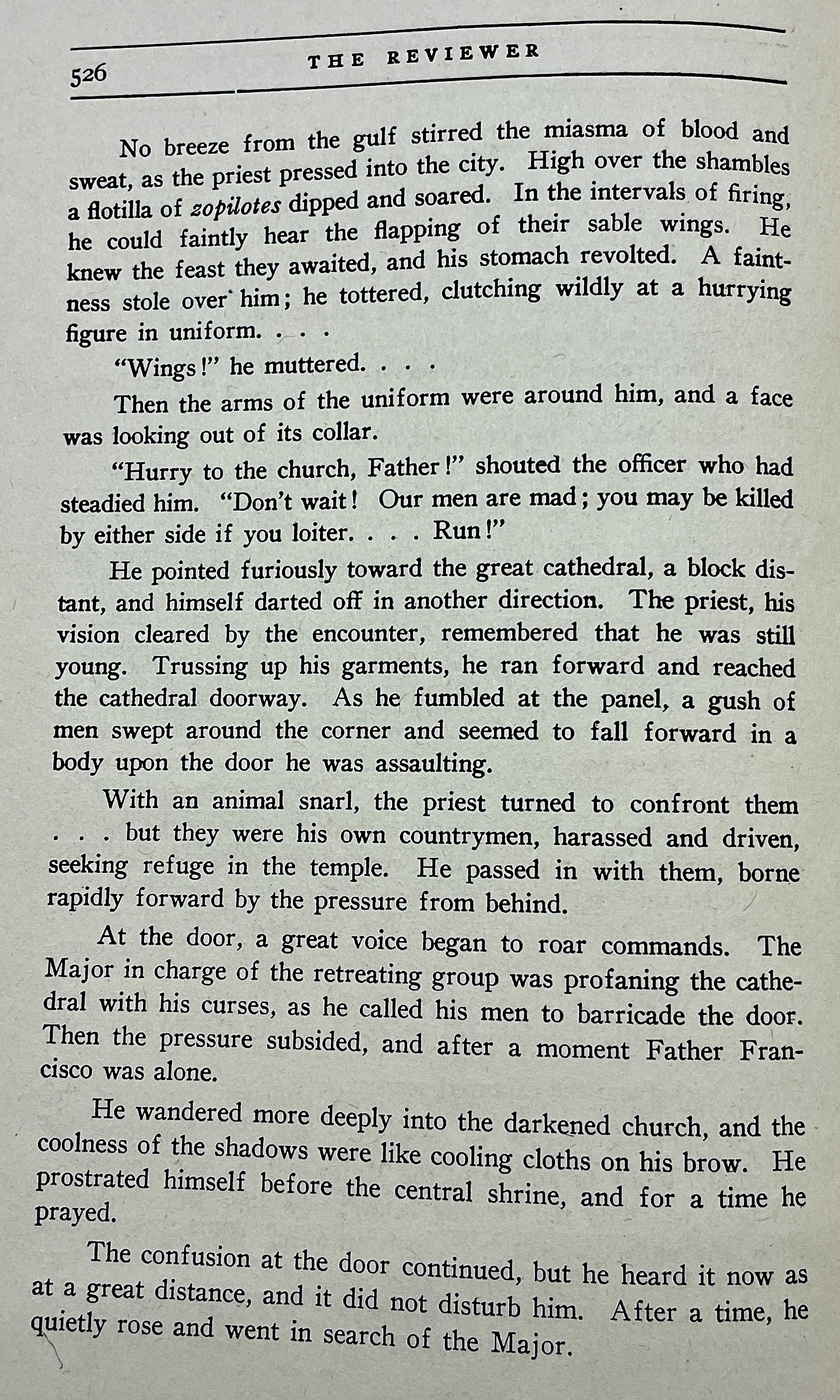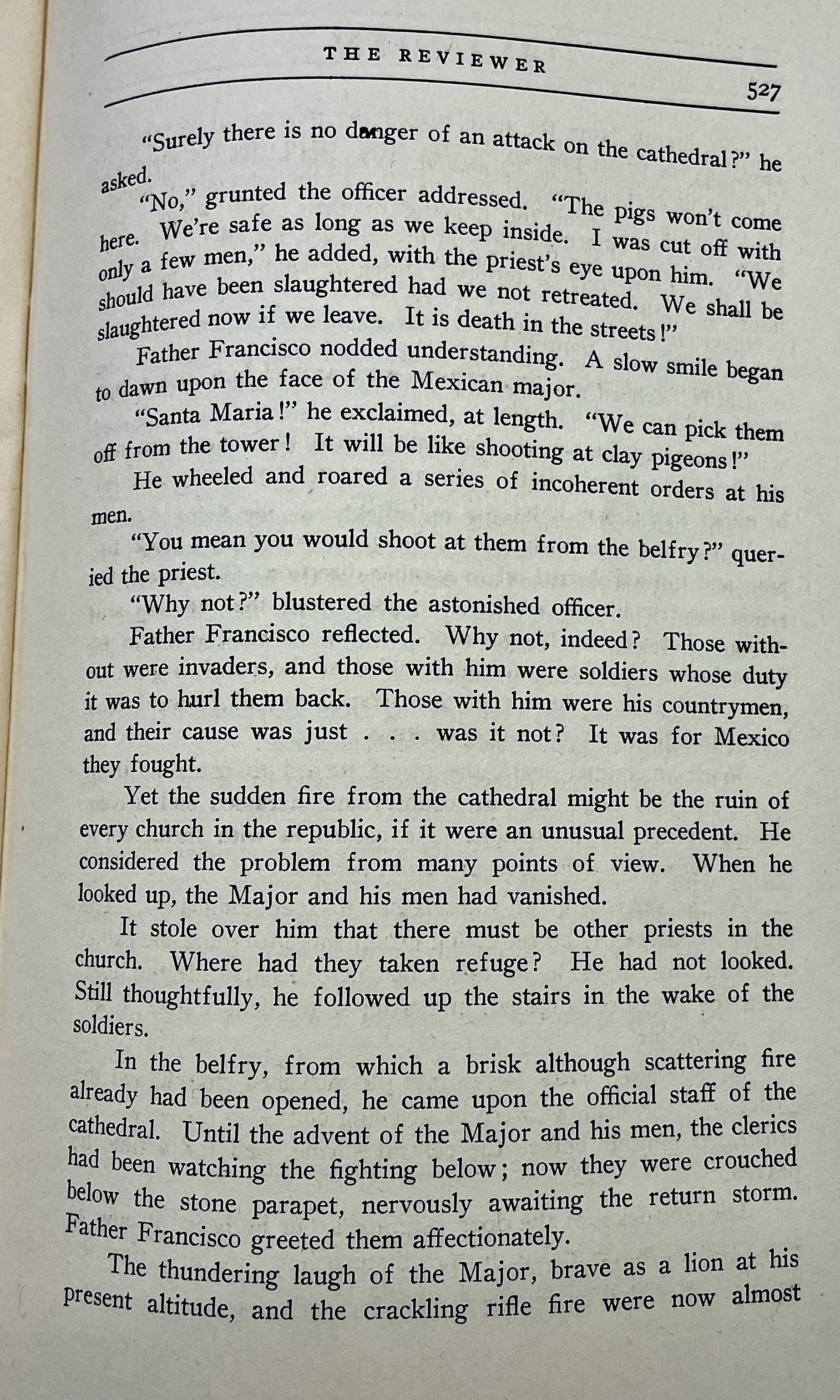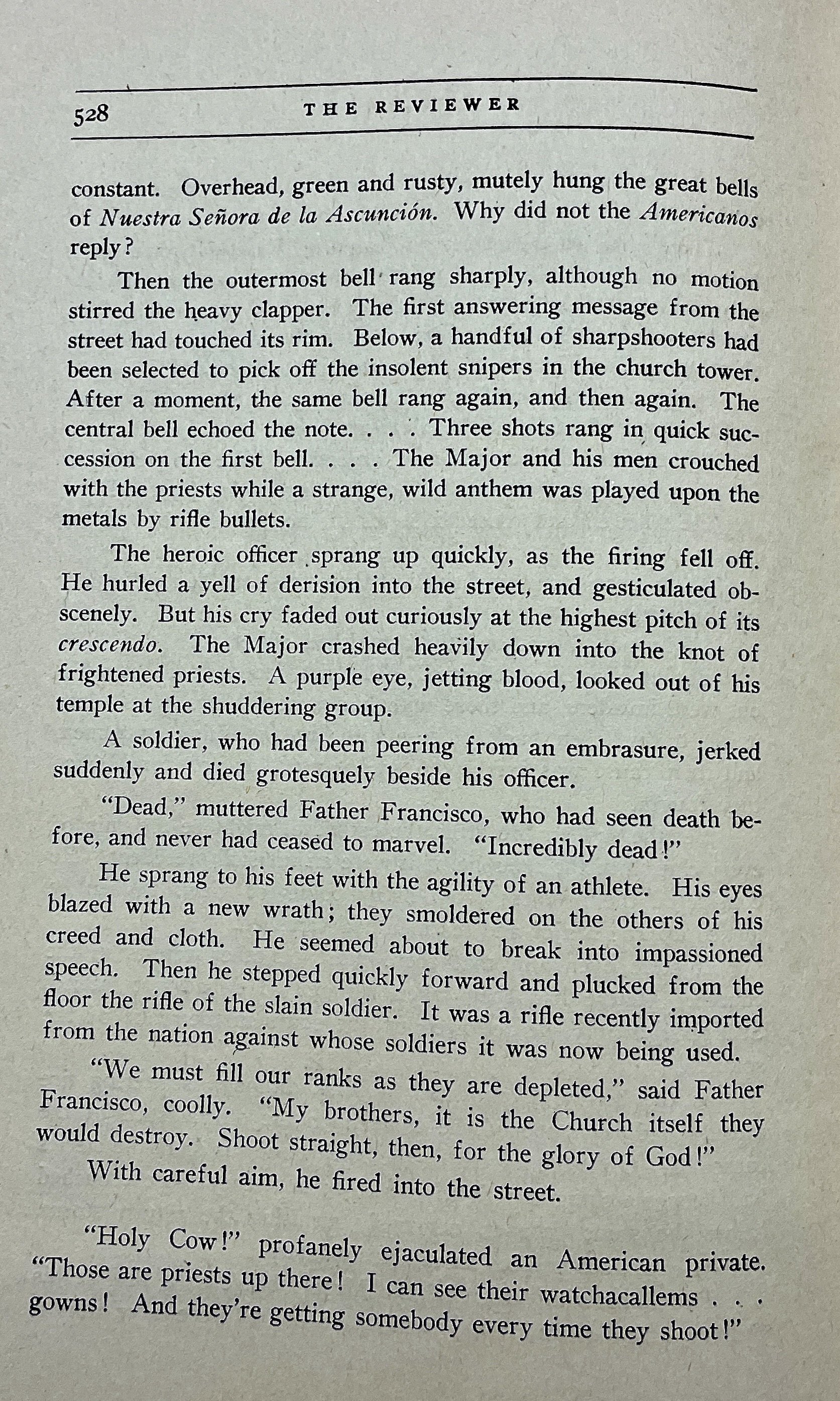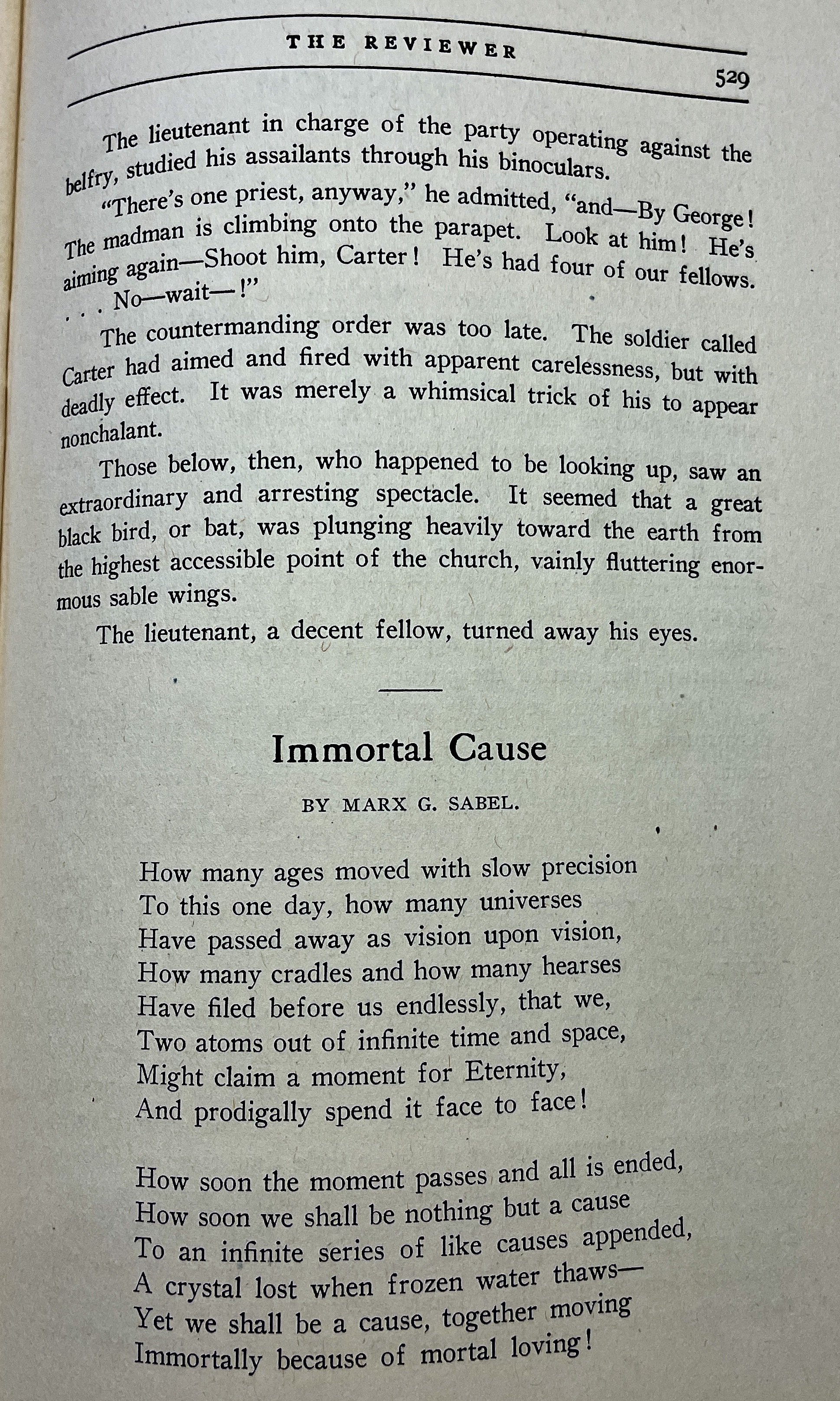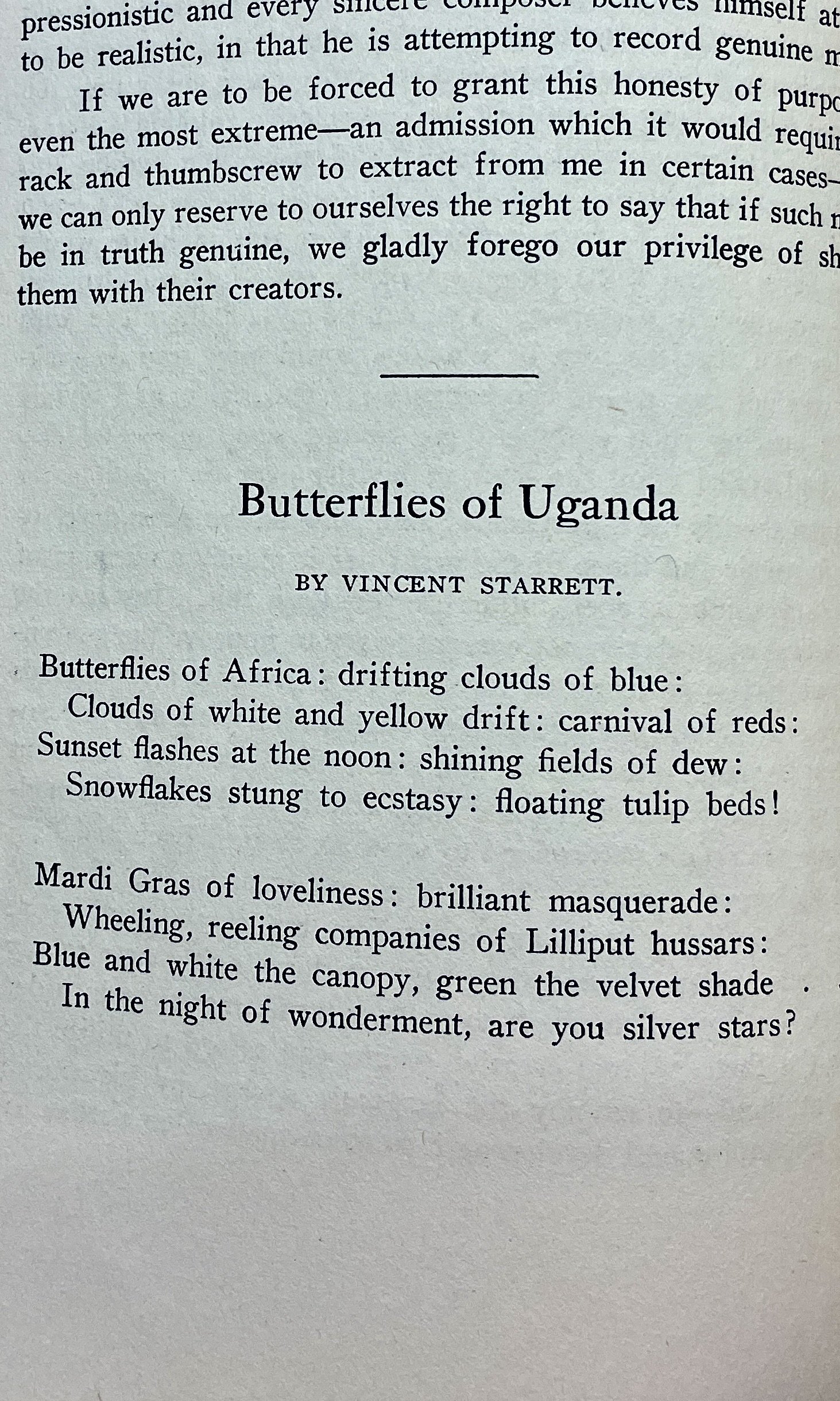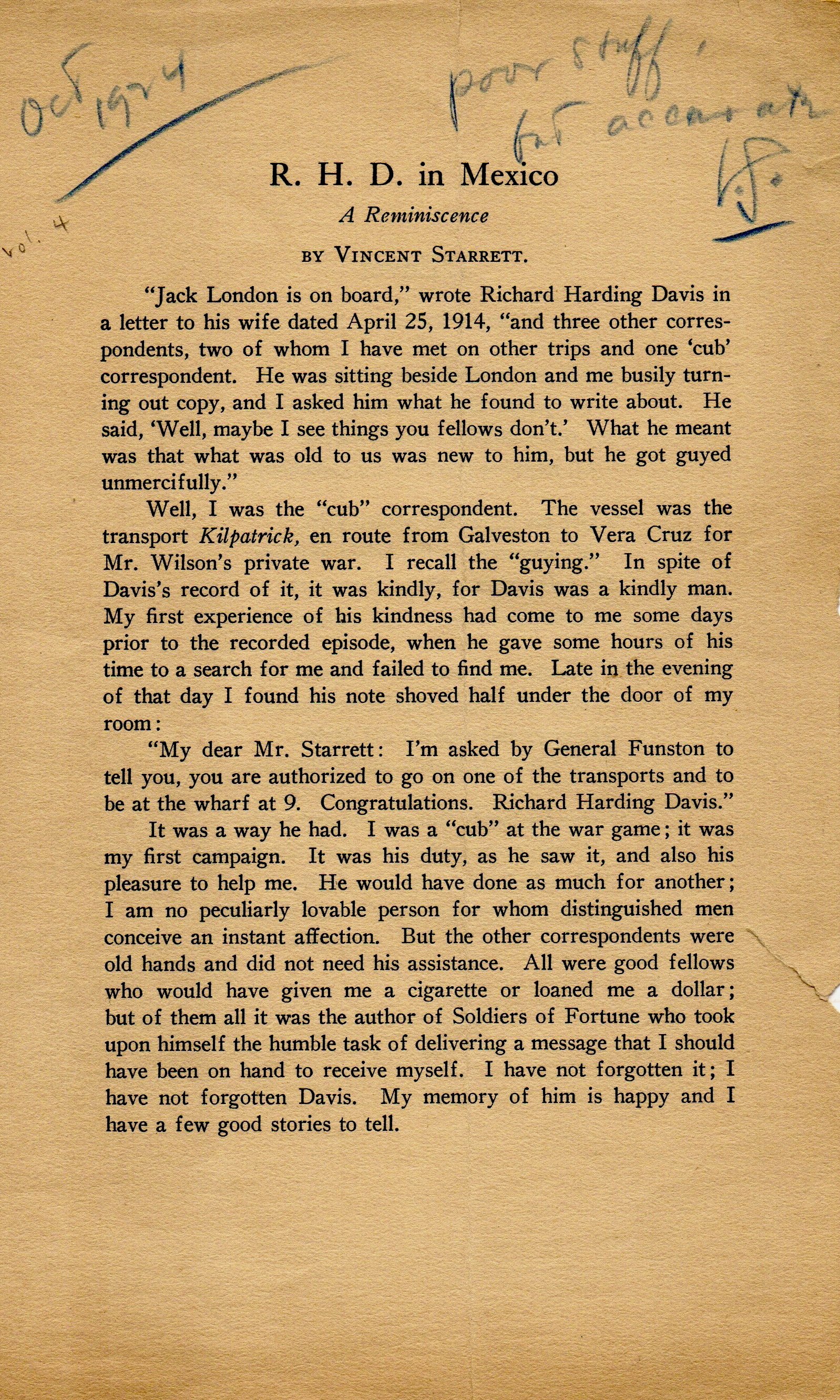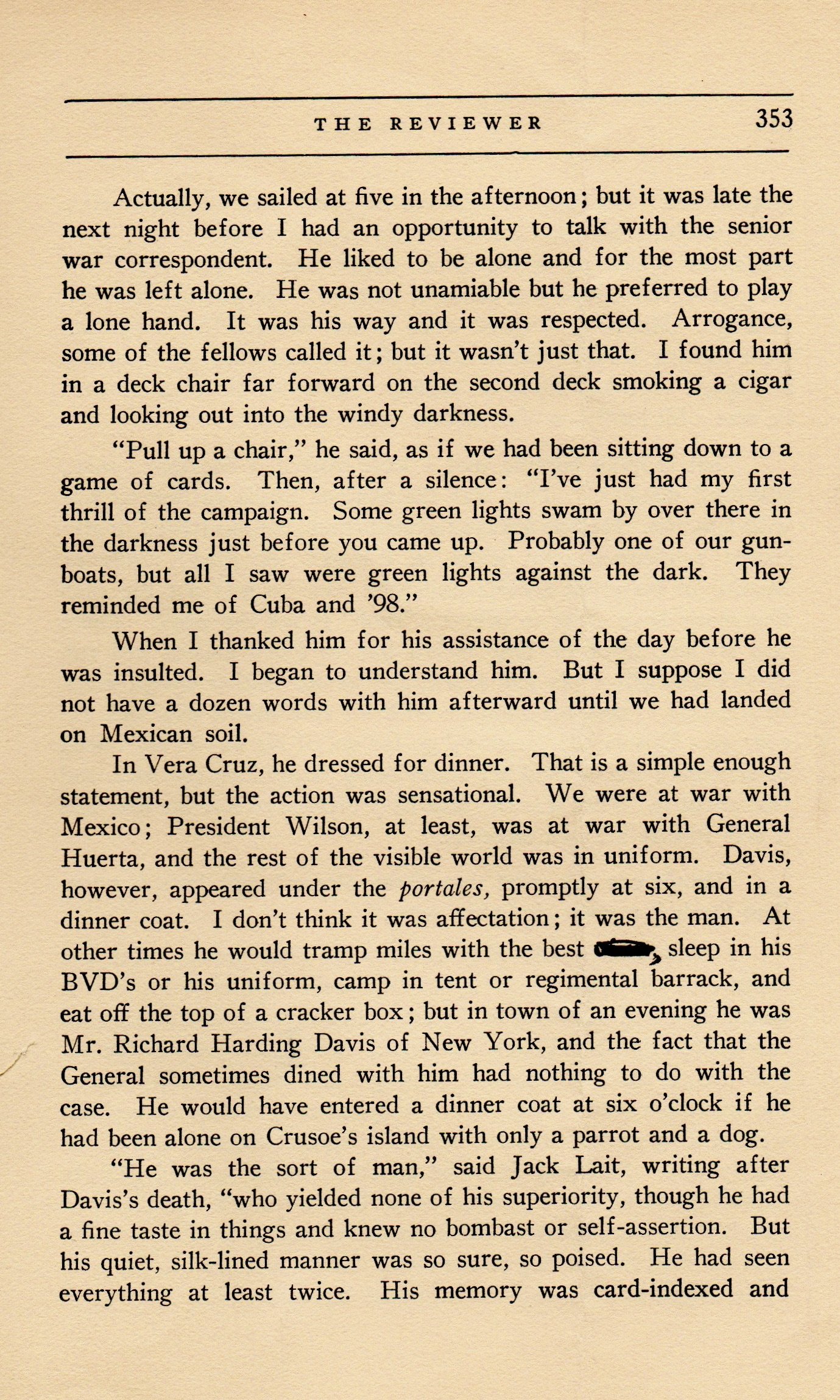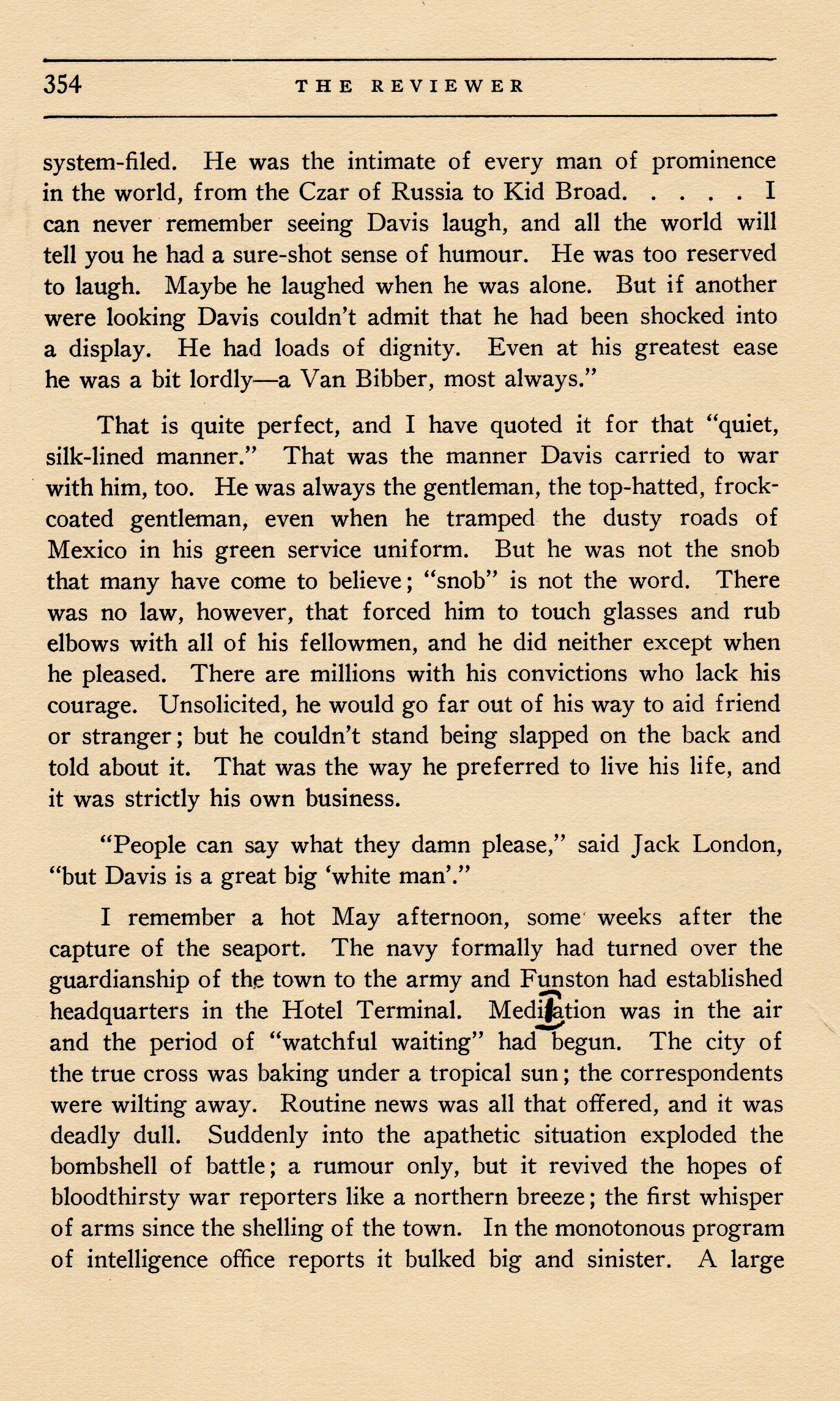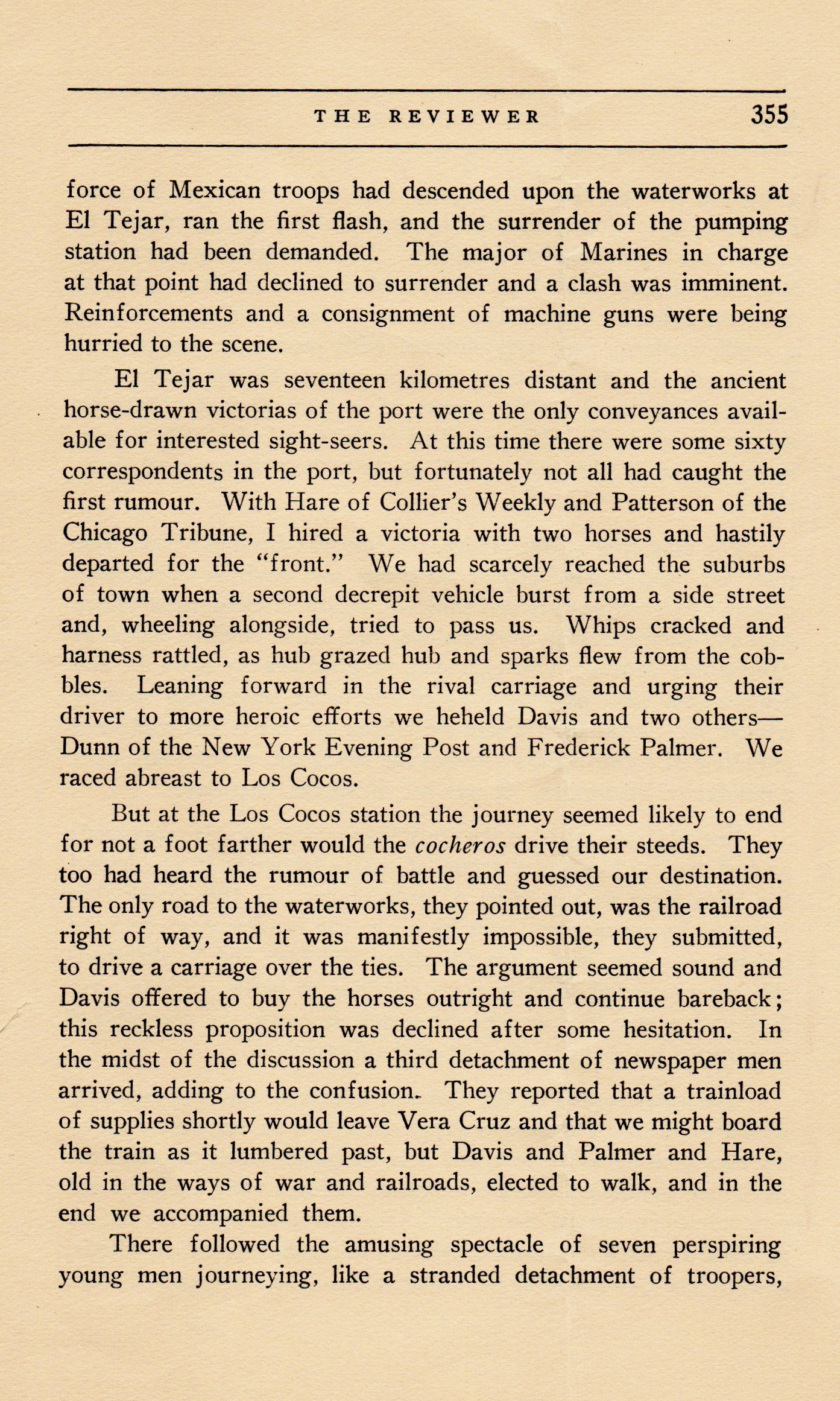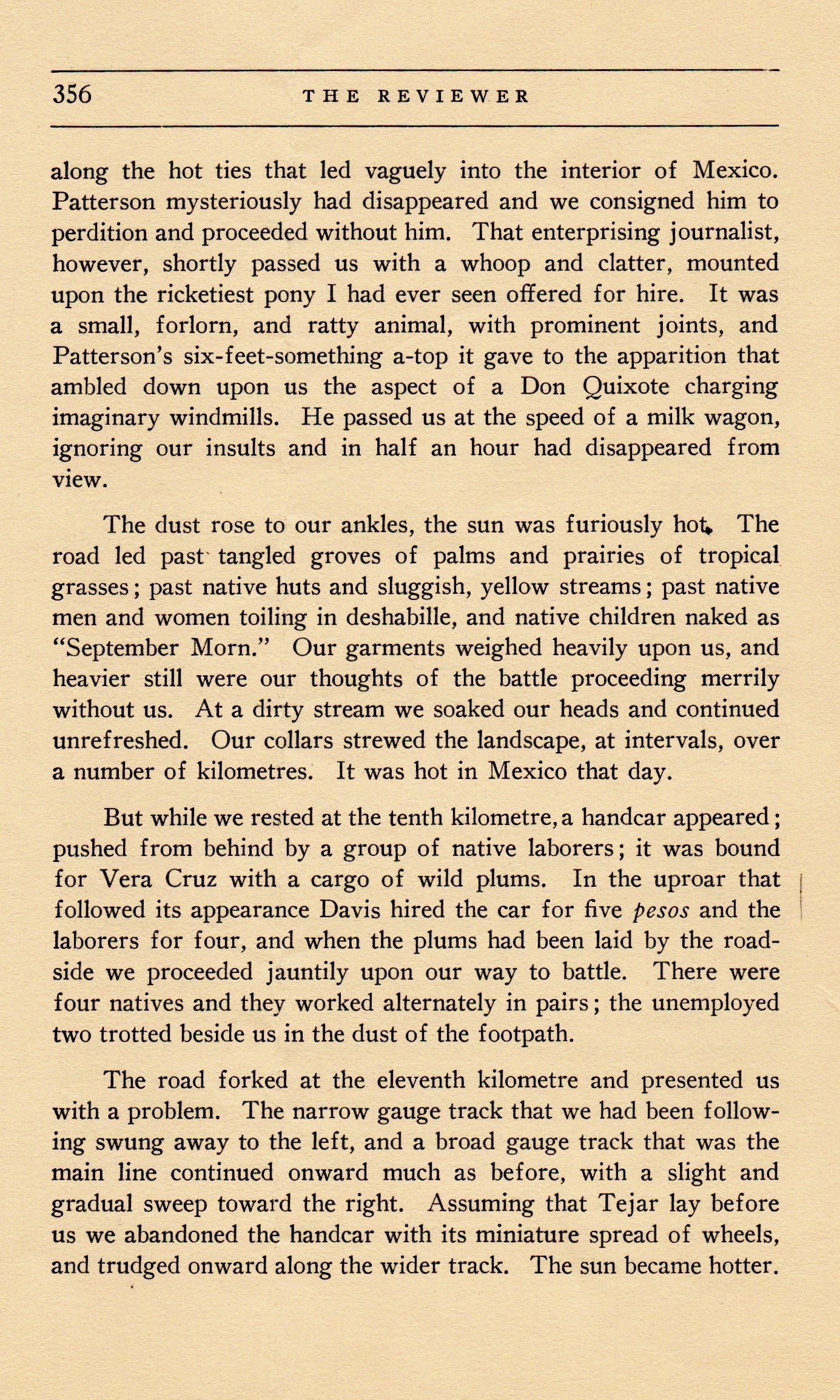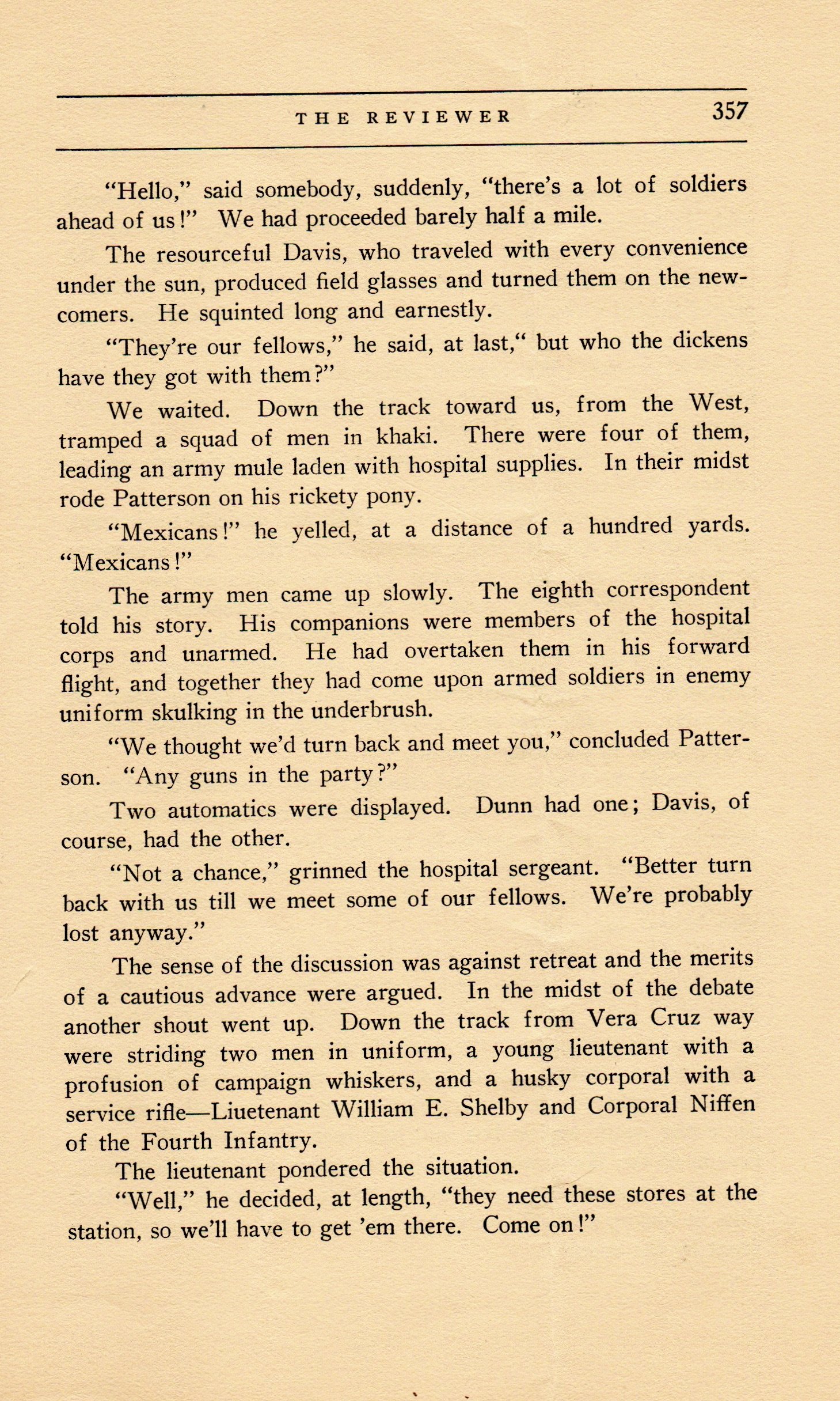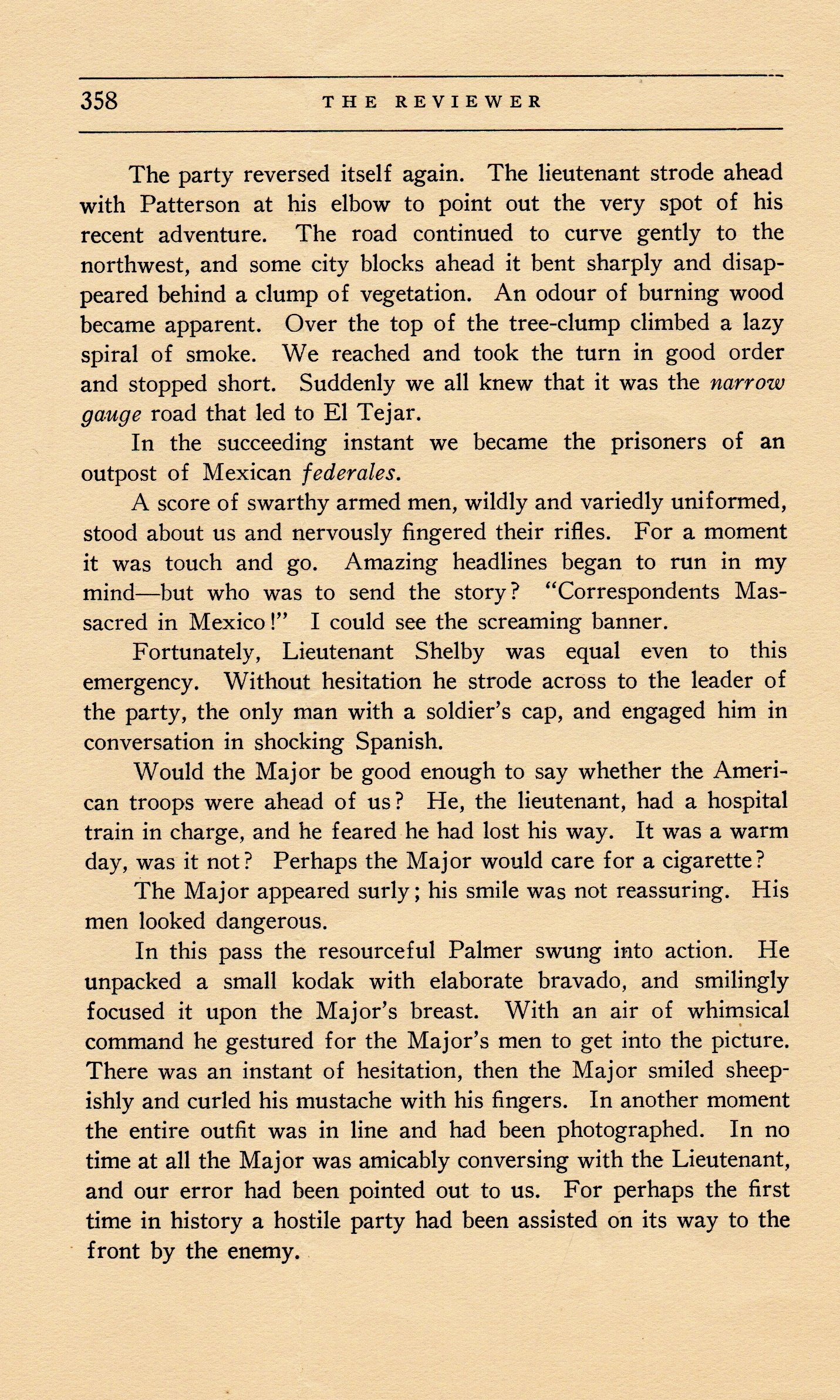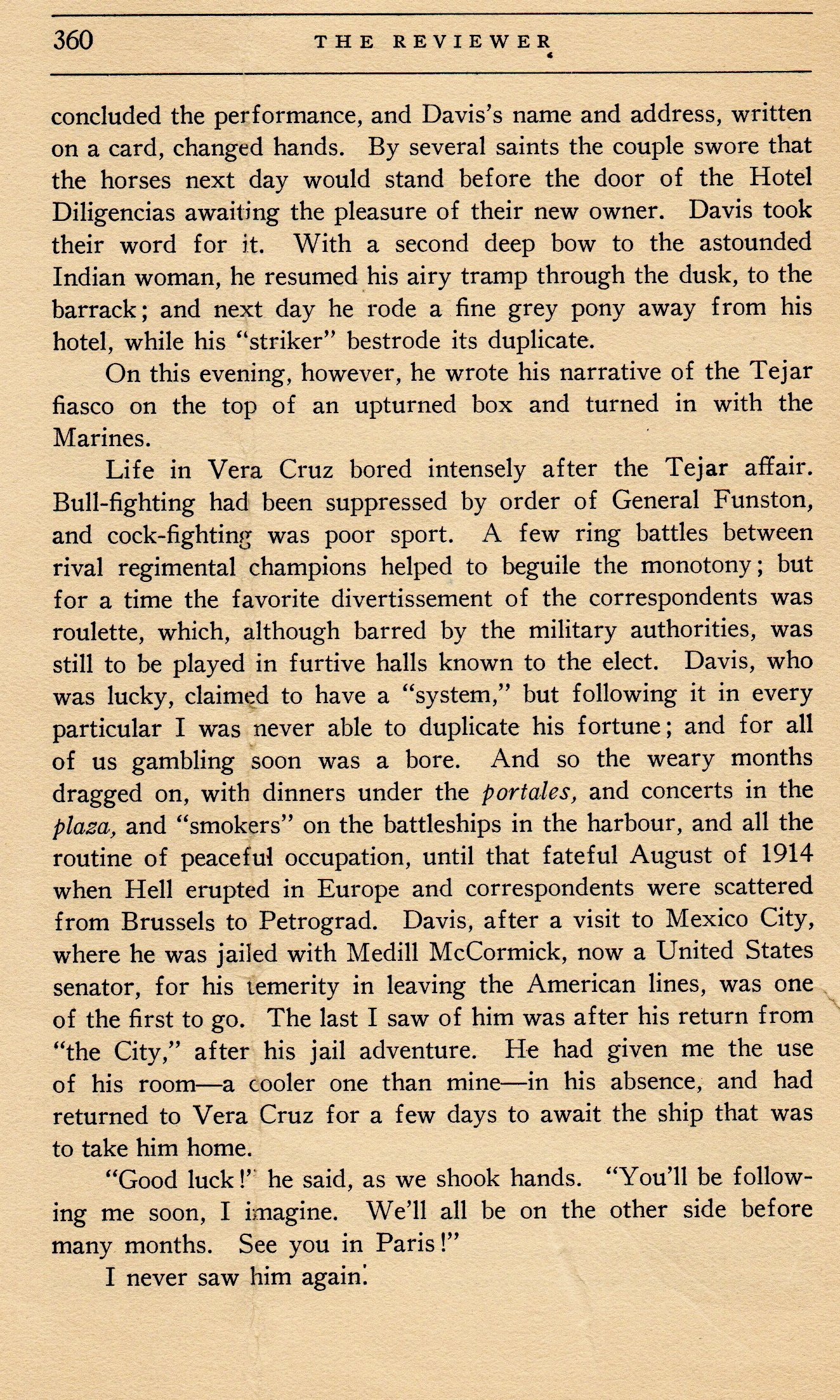'Poor Stuff, But Accurate'
Mexico, Chicago and Richmond meet in The Reviewer
Teddy Roosevelt and Richard Harding Davis in Florida in 1898. From Wikipedia.
In 1914, when Vincent Starrett was covering the Mexican uprising for the Chicago Daily News, he made the acquaintance of Richard Harding Davis. At the time, Davis was one of the best-known war reporters in the world.
Starrett was a young newspaperman on his first assignment as a war correspondent, green and eager.
Davis was the silent, elder statesman of the crowd. He helped the younger Starrett make his way among the 60 or so reporters living through the now largely forgotten American occupation of Vera Cruz.
Starrett learned a lot from watching Davis and the other seasoned war reporters during those months when battles were few and the heat never ended. A young reporter with ambitions, Starrett hoped the war would give him an opportunity for fame like that of Davis or Jack London. He enthusiastically sent back reports on every tidbit he could find, even on the relatively uneventful boat trip to Mexico.
Davis was amused, writing to his wife that Starrett was “busily turning out copy, and I asked him what he found to write about. He said, ‘Well, maybe I see things you fellows don’t.’ What he meant was that what was old to us was new to him, but he got guyed unmercifully.”
Some of what Starrett sent home made the papers, and a few of his reports were picked up by major newspapers back East. But his promising start soon sputtered.
It wasn’t his fault. Stories about the ups and downs of a confusing guerilla conflict in Mexico were quickly overwhelmed by The Great War in Europe.
As Europe exploded, Davis was told to leave Vera Cruz and head abroad. Starrett later recalled their farewell:
“Good luck!” (Davis) said as we shook hands. “You’ll be following me soon, I imagine. We’ll all be on the other side before many months. See you in Paris!”
I never saw him again.
Starrett back in the United States, wearing the uniform from Mexico. That’s his handwriting at the top of the photo. The dog was his pet, Princess, who was much friendlier than the Baskerville hound.
We know all about their interactions because of a reminiscence written by Starrett that was recently sent to me. It was part of a packet from a blog reader whose family knew Starrett many years ago.
A few of the pieces in the packet have comments from Starrett himself. “Poor stuff, but accurate,” he wrote on the first page of the article, which he dated to October 1924, a decade after the Mexican conflict and eight years after Davis died.
The article appeared in The Reviewer. I had never run across that publication so did a search through the Google. The results prompted me to take a trip 45 minutes northwest of here to the impressive James Branch Cabell Library of Virginia Commonwealth University in Richmond. The helpful staff had laid out the 35 issues of The Reviewer on a table for me to pour over.
It was a delightful two hours as you can see. Many thanks to the archivists at the VCU Special Collections and Archives division for making the search so easy.
The Reviewer was one of the many little literary magazines that popped up across the country in the early 1920s. Each had its own flavor, and the mission of the The Reviewer was to slap back at H.L. Mencken, who famously disparaged the literary talents of southern writers. (The VCU James Branch Cabell Library’s website has a very helpful history of the publication, which you can read here.) As the library notes:
The cover to a copy of The Reviewer for January 1923, with the barely legible notes from its editor, Emily Tapscott Clark. ETC, as she signed herself, scribbled her thoughts and the reactions of others on the covers of her copies of The Reviewer. These copies are now in the collection of the Virginia Commonwealth University’s James Branch Cabell Library.
Over the course of its 35 issues, The Reviewer published both established and new authors. The journal became important to Richmond intellectual life and added momentum to the larger Southern Renaissance.
Somehow, Starrett talked his way onto the contributors list. He was not Southern, but he was enthusiastic and prolific.
Like those days in Mexico when he produced stacks of copy for the readers back home, this was a time in his life when Starrett pounded the keyboard into the wee hours of the morning on a variety or projects. He wrote mystery stories featuring Jimmie Lavender for Short Stories magazine; odd and unusual tales for Mencken to consider printing in the Smart Set; an occasional column for another Southern magazine, The Double Dealer; and poetry for anyone who would publish it. Starrett also branched out and started his own little magazine, The Wave.
He somehow also found time for The Reviewer.
Starrett had four contributions in The Reviewer over the course of two years, a more than respectable showing. Except for staff members, there were few who had as many placements. Let’s take them in chronological order.
“Camera,” April 1922, Vol 3, No. 1

Starrett’s first piece was published in April, 1922, when the magazine was in its second year (but already on Volume 3) and had shifted from a twice-monthly to a monthly publication schedule. (It would soon become a quarterly publication. Such is the fate of publications that have great enthusiasm, limited numbers of readers and fewer advertisers.)
A photo postcard from Vera Cruz showing Starrett on horseback. On back Starrett wrote: “Two minutes after this was taken, the pony ran away with me! —Charlie” He sent the postcard to his brother Robert.
“Camera” is fiction, but so closely based on Starrett’s experiences in Mexico to be a shaded form of historical anecdote. The protagonist is a film reporter who has learned that one of Pancho Villa’s generals has been captured and will be executed. The reporter, with the preposterous name of William Dudley Murgatroyd, races to the scene of the execution.
He learns two things: first, the local comandante is in no hurry to execute the condemned rebel general and second, Murgatroyd has to leave the next day for another assignment. Murgatroyd bribes the local comandante with $10 to have the execution take place before he leaves.
The rebel general turns out to be a sad sack of a man, with a leg wounded in battle. He doesn’t look like a fierce war leader, and is as disheveled as the men who make up the firing squad. The prisoner can’t stand for his own execution and is given a chair to die in. The firing squad smiles for the camera as their leader gives Murgatroyd a friendly wave. It’s clear all this is being done to accommodate the reporter’s schedule. When everyone is certain that Murgatroyd’s camera is working, they execute the rebel soldier without hesitation.
“It was hours before Murgatroyd forgot the dreadful scene.”
Only hours? That’s a scene that would haunt me for the rest of my life.
“A DREAM OF WINGS,” June 1922, Vol. 3, No. 3
Two months later, the June 1922 issue published another tale from the Mexican civil war, “A Dream of Wings.”
Here Starrett looks through the eyes of a local priest, who has dreamt of flying, “to take wing and soar away, far over the squalid rooftops of his native village, over the highest palm trees and mountains … stopping for a time in Spain, and again in Rome to visit the Holy Father; but for the most part, he only flew, flew, high over the earth, with rushing, shining wings and the voice of a trumpet.”
Starrett in a portrait photograph in his uniform.
His reality is much grimmer. The priest’s village comes under fire by American troops and he rushes to the church in a mad scramble of local residents. Some are fighting against the better trained Americans who have taken over the area. After seeing his fellow villagers killed, the priest becomes infuriated, and climbs to the bell tower with a rifle, where he is shot by an American soldier.
“Those below, then, who happened to be looking up, saw an extraordinary and arresting spectacle. It seems that a great black bird or bat was plunging heavily toward the earth from the highest possible point of the church, vainly fluttering enormous, sable wings.”
Like the camera operator in “Camera,” the soldier who had been ordered to shoot the priest feels a wave of disgust and regret, and “turned away his eyes.”
“Butterflies of Uganda,” October 1922, Vol. 3, Nos. 5&6
Starrett’s third contribution to The Reviewer is a brief verse, “Butterflies of Uganda.”
So far as I know, Starrett never visited Uganda. I can find no clear inspiration for this brief poem.
It’s also not a poem I’ve seen reprinted elsewhere.
“R.H.D. in Mexico,” October 1924, Vol. 4, No. 5
The last entry for Starrett in The Reviewer is the first one we discussed and the one that kicked off this search, “R.H.D in Mexico.” As Starrett noted, it appeared in the October 1924 issue.
You will notice the images reproduced here here vary a bit in quality. The cover is from the VCU collection. The remaining pages are from the packet sent in by a friend of the blog.
By this time, reality was hitting The Reviewer hard. This issue is the last one to be published in Richmond. Four more issues were published at Chapel Hill, North Carolina, but the end was in sight. Like Starrett’s own little magazine, The Reviewer started with grand hopes and dreams, but collapsed as reality sank in. Still, the little journal proved that there were voices in the South—and elsewhere—worth reading.
A few observations:
Starrett’s contributions were clearly reflections on his time as a war correspondent, from a distance of 10 years. As a youth, he read adventure tales by authors like G.A. Henty that glorified the valor of young men fighting for their God and country. In truth, Starrett saw ragged men with no training fighting a government they felt was failing them, who were also confronted by American forces who had no right being there. Whatever glory Starrett sought in war was sweated out of him in the miserable, lonely nights spent in Vera Cruz.
His only hope for fame as a war correspondent was to be sent by the Daily News to cover the war in Europe. He got no farther East than Washington, DC.There were many impressive contributors to The Reviewer, including names that would be nationally recognized at the time and still respected today. Besides James Branch Cabell (who edited three issues), there was John Galsworthy, Ellen Glasgow, Maxwell Bodenheim, Louis Untermeyer, Agnes Repplier, Burton Rascoe and Carl Van Vechten. Some were from the South, but others were no more Southern than Starrett.
One name I was not expecting to see was Frank Vigor Morley, Christopher Morley’s brother and a member of the Baker Street Irregulars with the investiture “The Three Garridebs.” Morley wrote an extended appreciation of British essayist Arthur Clutton-Brock.
Another name I was not expecting was Arthur Machen, with whom Starrett had a significant relationship. While it is tempting to think that Starrett had something to do with Machen’s two appearances in The Reviewer, there is a greater likelihood that Hunter Stagg, the journal’s Literary Editor was responsible. Stagg was a corresponding friend of Machen’s.
Stagg was also not above insulting Starrett in print. When Machen and Starrett had a falling out, the Welsh writer turned to Stagg (through their mutual friend Montgomery Evans) to denounce Starrett in print. Stagg obliged in a vicious article for The Richmond Times-Dispatch in July of 1924. It was headlined: “Machen Prestige Hit By ‘Et Cetera’/Vincent Starrett Takes Poor Way of Showing Admiration by Collecting Relics of Authors Lean and Hungry Days.”
That gives you a sense of the article’s tone.In October 1925, The Reviewer published its last issue.
In his book, War Correspondent, published by The Battered Silicon Dispatch Box in 1999, Peter Ruber reprinted “A Dream of Wings,” “R.H.D in Mexico” and “Camera.”
It appears Ruber didn’t know about The Reviewer, since he says “A Dream of Wings” comes from corrected magazine galley proofs but says the magazine’s name is unknown. He reports the other two stories as “unpublished.” It’s good to know I wasn’t the only Starrett fan who had never heard of The Reviewer.
Ruber has useful information on Starrett’s role as war correspondent in this volume.
Next time, I’m headed to a library much closer to home to visit an old friend.


